What is the application of SLA 3D printing in the process of industrial product R&D testing and proofing?
With the rapid advancement of technology, 3D printing has gradually become a shining gem in the field of manufacturing. It not only excels in production but also plays a crucial role in research and development testing. Today, let's explore together the unique charm of
SLA 3D printers in R&D testing, and delve into ACMEMFG 3D's star product—the R&D Accelerator H360.
I. Outstanding Applications of 3D Printing in R&D Testing
Prototype Production: Say goodbye to traditional cumbersome processes and achieve one-touch molding.
On the journey of product development, prototype production is indispensable. Traditional methods involve various processes such as design, manufacturing, and processing, which are time-consuming and laborious. However, 3D printing technology magically transforms designs directly into tangible physical models, greatly shortening the production cycle and reducing costs. With its outstanding printing accuracy, the H360 effortlessly handles the production of complex prototypes, accelerating your R&D journey.
Testing and Validation: Precise and efficient, boosting product performance.
Testing and validation are crucial in the product development process as they relate to product performance and quality. With its efficient and convenient characteristics, 3D printing technology provides powerful support for testing and validation. The H360 can rapidly manufacture various parts and components, allowing you to conduct testing and validation promptly, identify and resolve issues in a timely manner, ensuring superior product performance.
Customized Production: Meeting personalized needs, leading market trends.
In today's increasingly diverse consumer demand, customized production has become the new favorite of the market. With its unique advantages, 3D printing technology can meet the personalized needs of different consumers. With its flexible customization capability, the H360 can quickly manufacture various customized parts and components according to customer requirements, winning favor for your products in the market.
II. Parameters and Selling Points of ACMEMFG 3D H360:
Parameters:
Printing Technology: Stereolithography (SLA)
Printing Size: 360mm × 360mm × 360mm
Printing Accuracy: ±0.1mm
Spot Accuracy: 0.05mm
Printing Speed: Up to 50mm/hour
Light Source Type: 405nm LED UV Light Source
Material Compatibility: Supports various light-cured resin materials
Operating System: ACMEMFG 3D self-developed operating system
Connection Method: USB, WiFi
Selling Points:
Large Printing Size: A printing space of 360mm × 360mm × 300mm, suitable for producing large-sized models or parts.
High Precision Printing: Printing accuracy of ±0.1mm and spot accuracy of 0.05mm, ensuring printing quality and detail.
Fast Printing Speed: Up to 50mm/hour printing speed, quickly realizing product prototype production.
Multi-Material Compatibility: Supports various light-cured resin materials to meet the needs of different industries.
Self-developed Operating System: ACMEMFG 3D's self-developed operating system, user-friendly and powerful functionality.
Flexible Connection Methods: Supports USB and WiFi connections, convenient for connection and use with computers or other devices.
The above parameters and selling points highlight the advantages of the H360 in large-size printing, high-precision printing, fast printing, multi-material compatibility, and ease of operation, suitable for rapid prototyping and small-batch production in various industries.
III. Significant Advantages of 3D Printing in R&D Testing
Rapid Manufacturing: With its efficient printing speed, the H360 helps you quickly complete prototype production and component manufacturing, shortening the R&D cycle.
Cost Reduction: 3D printing technology reduces material waste and labor costs, saving valuable R&D funds.
Improved Accuracy: With its excellent printing accuracy, the H360 ensures the accuracy of parts and components, enhancing product quality.
High Flexibility: Whether it's complex shapes or special structures, the H360 can easily handle them, meeting your diverse customization needs.
IV. Challenges and Prospects of 3D Printing in R&D Testing
Although 3D printing technology demonstrates significant advantages in R&D testing, it still faces some challenges such as technical bottlenecks, equipment costs, and material limitations. However, with the continuous development of technology, it is believed that these challenges will gradually be resolved. In the future, 3D printing technology will play a more extensive and in-depth role in the field of R&D testing, bringing more possibilities for product innovation and development.
V. Conclusion
3D printing technology shines in the field of R&D testing with its unique advantages. As ACMEMFG 3D's star product, the H360 provides strong support for your product development and testing with its outstanding performance and flexible customization capabilities. Let's work together to explore more possibilities of 3D printing technology in R&D testing and create a better future!



